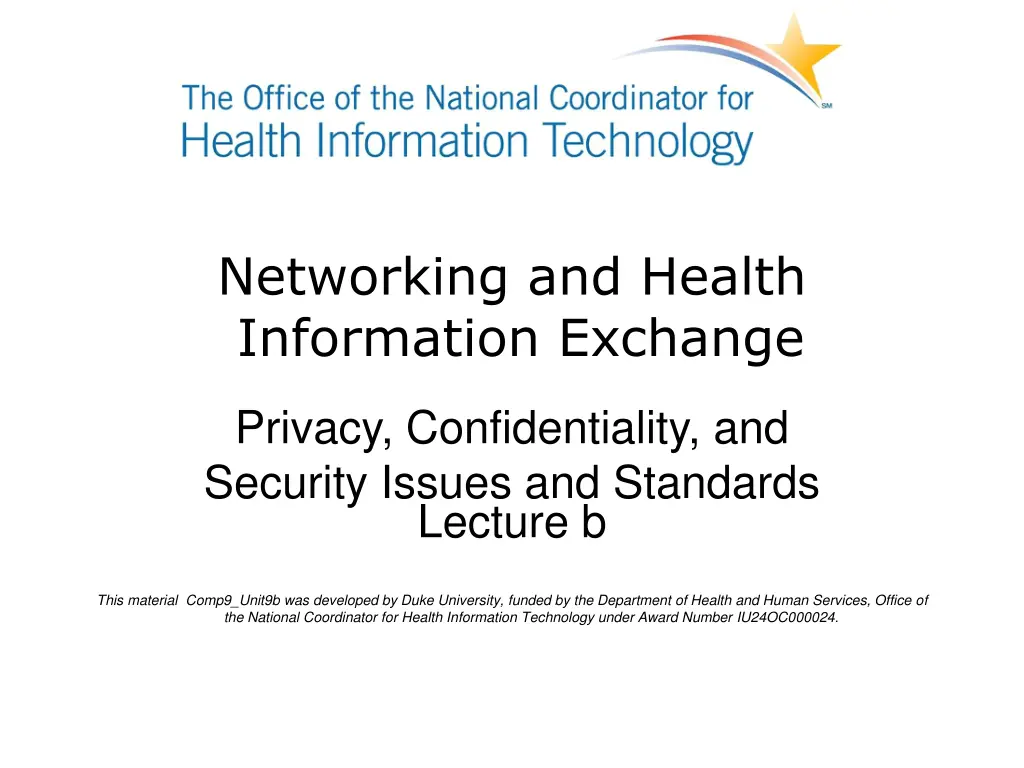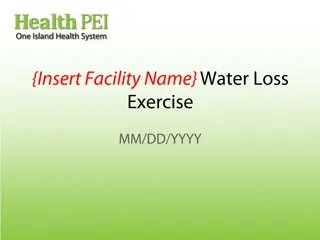
Networking and Health Information Exchange Privacy, Confidentiality, and Security Best Practices
Explore the critical aspects of access control methods, restrictions to data storage and retrieval, and best practices in ensuring privacy, confidentiality, and security in networking and health information exchange. Learn about access control models, types, and account restrictions for a robust information security framework.
Uploaded on | 0 Views
Download Presentation

Please find below an Image/Link to download the presentation.
The content on the website is provided AS IS for your information and personal use only. It may not be sold, licensed, or shared on other websites without obtaining consent from the author. If you encounter any issues during the download, it is possible that the publisher has removed the file from their server.
You are allowed to download the files provided on this website for personal or commercial use, subject to the condition that they are used lawfully. All files are the property of their respective owners.
The content on the website is provided AS IS for your information and personal use only. It may not be sold, licensed, or shared on other websites without obtaining consent from the author.
E N D
Presentation Transcript
Networking and Health Information Exchange Privacy, Confidentiality, and Security Issues and Standards Lecture b This material Comp9_Unit9b was developed by Duke University, funded by the Department of Health and Human Services, Office of the National Coordinator for Health Information Technology under Award Number IU24OC000024.
Privacy, Confidentiality, and Security Issues and Standards Learning Objectives 1. Define access control methods. 2. Analyze access restrictions to data storage and retrieval (physical and software). 2
Access Control Who or what is allowed access to a particular resource and what level of access are they allowed. Terminology Identification Authentication Authorization 3
Access Control Best Practices Separation of duties Require more than 1 person to perform an action Least privilege Only give user the access needed 4
Access Control Models Discretionary Access Control (DAC) Mandatory Access Control (MAC) Role Based Access Control (RBAC) 5
Access Control Types Logical Access to data files, programs and networks o Access Control Lists (ACLs) o Account Restrictions o Passwords Physical Access to physical locations o Locks o Badges o Mantraps 6
Access Control List (ACL) An ACL is a list that is associated with file, directory or object that lists who has access to it and what access they have. Image courtesy of Michele Parrish 7
Account Restrictions Account expiration Time of day Login location Image courtesy of Michele Parrish 8
Passwords Combination of letters, numbers and special characters Recommend upper and lower case characters The more characters the better Should be changed frequently 9
Passwords Should Never Be default passwords Should never be written down Should never be a word in a dictionary, words spelled backwards, common misspellings, and abbreviations (English or other languages) 10
Passwords Should Never (Continued) Be used for more than one account Contain personal information Social engineering 11
One-Time Passwords (OTP) Change frequently Only used once Synchronized with authentication server 12
Physical Access Control Location Doors Video surveillance Access log Mantrap 13
Biometrics Fingerprints Faces Hands Irises/Retinas Behavioral Keystroke Voice Cognitive 14
Authentication Practices Layering Multi-factor Single Sign-On (SSO) Image courtesy of Michele Parrish 15
Virtual Private Networks (VPNs) Internet technology to transmit data between sites Data is encrypted 16
Security Policies A collection of policies that lay out specific rules and requirements that must be followed in order to provide a secure environment. 17
Privacy, Confidentiality, and Security Issues and Standards Summary Concepts of privacy and confidentiality How to secure data Access control methods Access restrictions to data storage and retrieval 18
Privacy, Confidentiality, and Security Issues and Standards References Lecture b References References were not used for this lecture Images Slide 7: ACLs. Courtesy Michele Parrish. Used with permission. Slide 8: Time Restrictions. Courtesy Michele Parrish. Used with permission. Slide 15: Single Sign-On. Courtesy Michele Parrish. Used with permission. 19
Privacy, Confidentiality, and Security Issues and Standards Lecture b This material was developed by Duke University, funded by the Department of Health and Human Services, Office of the National Coordinator for Health Information Technology under Award Number IU24OC000024. This material was updated by Normandale Community College, funded under Award Number 90WT0003. 20






















